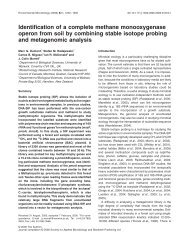Conservation of the vaquita Phocoena sinus - The Department of ...
Conservation of the vaquita Phocoena sinus - The Department of ...
Conservation of the vaquita Phocoena sinus - The Department of ...
You also want an ePaper? Increase the reach of your titles
YUMPU automatically turns print PDFs into web optimized ePapers that Google loves.
180 L. Rojas-Bracho, R. R. Reeves and A. Jaramillo-Legorreta<br />
INTRODUCTION<br />
<strong>The</strong> Mexican fishery laws must somehow be made to work, or <strong>the</strong> species will die out before we<br />
come to know it. Even a few paid rangers with a couple <strong>of</strong> good boats might halt <strong>the</strong> decline, as<br />
would new jobs for fishermen. But will those things happen?<br />
Norris (1992)<br />
Those words, written in 1992 by one <strong>of</strong> <strong>the</strong> two describers <strong>of</strong> <strong>the</strong> <strong>vaquita</strong> <strong>Phocoena</strong> <strong>sinus</strong><br />
Norris & McFarland (1958), are as fitting in 2006 as <strong>the</strong>y were <strong>the</strong>n. <strong>The</strong> <strong>vaquita</strong> is in close<br />
competition with <strong>the</strong> baiji Lipotes vexillifer,<br />
or Yangtze River dolphin, for <strong>the</strong> dubious<br />
distinction <strong>of</strong> being <strong>the</strong> most critically endangered species <strong>of</strong> small cetacean in <strong>the</strong> world. <strong>The</strong><br />
<strong>vaquita</strong> is a small porpoise (1.5 m, 50 kg; Fig. 1) and is endemic to <strong>the</strong> nor<strong>the</strong>rn reaches <strong>of</strong><br />
<strong>the</strong> Gulf <strong>of</strong> California, Mexico. Its known modern distribution encompasses a water surface<br />
2<br />
area <strong>of</strong> only about 4000 km , which means that its total extent <strong>of</strong> occurrence is far smaller<br />
than that <strong>of</strong> any o<strong>the</strong>r living species <strong>of</strong> marine cetacean. By <strong>the</strong> time <strong>of</strong> its scientific discovery<br />
and formal description in 1958, <strong>the</strong> <strong>vaquita</strong> was already seldom seen, difficult to observe, and<br />
probably not very abundant. Apart from <strong>the</strong> few cursory observations reported by Norris &<br />
McFarland (1958) and Norris & Prescott (1961), and a few additional records described by<br />
Orr (1969) and Noble & Fraser (1971), <strong>the</strong> <strong>vaquita</strong> remained largely unknown until <strong>the</strong> 1980s,<br />
when intensive, focused efforts were made to find living animals and to document <strong>the</strong>ir<br />
numbers, distribution and behaviour.<br />
Only four living species comprise <strong>the</strong> genus <strong>Phocoena</strong>,<br />
two in <strong>the</strong> Nor<strong>the</strong>rn Hemisphere<br />
(<strong>the</strong> <strong>vaquita</strong> and <strong>the</strong> harbour porpoise P. phocoena)<br />
and two in <strong>the</strong> Sou<strong>the</strong>rn Hemisphere<br />
(<strong>the</strong> spectacled porpoise P. dioptrica and Burmeister’s porpoise P. spinipinnis).<br />
All are small<br />
in body size and coastal in distribution (although <strong>the</strong>re is some evidence to suggest that <strong>the</strong><br />
spectacled porpoise has a partly <strong>of</strong>fshore distribution; Brownell & Clapham, 1999a). Ano<strong>the</strong>r<br />
common feature <strong>of</strong> <strong>the</strong> four species is that <strong>the</strong>y are highly vulnerable to incidental mortality<br />
in gillnet fisheries (Jefferson & Curry, 1994). <strong>The</strong>re is no reason to suppose that <strong>the</strong> <strong>vaquita</strong><br />
is any more, or less, susceptible to accidental entanglement in gill nets than any o<strong>the</strong>r<br />
Fig. 1. A <strong>vaquita</strong> showing <strong>the</strong> head and anterior pigmentation pattern. Note <strong>the</strong> dark grey dorsal cape and<br />
<strong>the</strong> pale grey lateral field. <strong>The</strong> most conspicuous features are <strong>the</strong> relatively large black eye and lip patches. This<br />
animal died in an experimental totoaba fishery and was landed in El Golfo de Santa Clara, March 1985 (Photo<br />
by A. Robles).<br />
© 2006 <strong>The</strong> Authors. Issue compilation © 2006 Mammal Society,<br />
Mammal Review,<br />
36, 179–216




